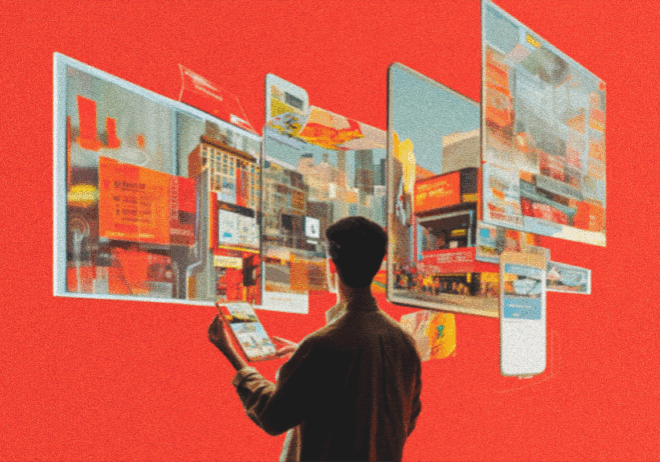
How B2B Brands Use an Omnichannel Marketing Strategy to Connect
Have you ever wondered how powerful it can be to reach your audience through multiple channels, all working together? Think about it as a marketing strategy where every touchpoint — social media, email, website and beyond — is seamlessly integrated into one cohesive plan. That’s what omnichannel is all about.
An omnichannel marketing strategy can sound complex, but it simply acts like a root of plant. Just as roots spread out to nourish and support the plant, omnichannel marketing uses multiple channels to reach and engage with the audience for optimal communication. In this blog, we will discover how omnichannel enhances brand presence and creates a unified, engaging experience for audiences.
New B2B buyers are more tech-savvy and sophisticated in their approach. They don’t just rely on one source of information but instead, connect with ten different channels before making any purchase. B2B marketers need to be present wherever their clients are. Adapting this innovative approach is essential for brands to create a unified and seamless experience across all touchpoints.
Here’s how omnichannel marketing creates seamless experiences
Today, around 94% of B2B decision-makers say that an omnichannel sales model is the most effective to cement their favor. Whether it’s social media platforms, content hubs, webinars, virtual events, or email marketing, each plays an integral role in creating an effective marketing strategy.
Social media: While traditional social media channels (FB, IG, X) aren’t to be overlooked, brands are turning to alternate social media channels for advertising, too. Sites like Reddit, Pinterest, Goodreads, Quora, and discord are all being factored into a new strategy.
Webinars and virtual events: Such events allow deep diving into complex topics and positioning your brand as an industry leader.
LinkedIn: Offers a professional environment for networking and sharing industry insights, making it crucial for B2B engagement.
Content hubs: Content hubs can drive inbound traffic and establish your brand as a trusted resource.
To make marketing fun and practical, B2B marketers can strategically leverage these channels to connect with their potential audience. Ignoring or leaving these channels means missing priceless opportunities to build customer relationships and drive business growth. This innovative approach can help marketers to stay ahead of the competition and deliver exemplary leads.
We can’t ignore one important key component of omnichannel marketing: real-time engagement. B2B customers expect timely responses and a seamless customer experience. Tools like live chat, AI-driven chatbots, and personalized emails ensure immediate support to customers.
Here are key strategies for B2B marketers to nail channel integration
Seamless customer experience remains elusive, as it must rely on detailed research and insights on customer behavior across all of these channels. Sure, marketing across 10 channels can be easy but the real challenge is making them work together harmoniously. To see how B2B brands are successfully achieving this, let’s dive in and explore their strategies.
Consistent messaging: It is important for B2B marketers to ensure that your brand’s message is consistent across all the channels, as it will help reinforce your brand value and identity. Whether it’s a small campaign or social media post, maintaining consistency in tone can deliver cohesive experience.
Data synchronization: Real-time insights, in-depth research and client interactions allow brands to deliver personalized approach to customers so that they can rely on them and buy product hassle-free.
Cross-channel promotions: Using cross-channel promotions to drive traffic between platforms can enhance engagement. For example, a webinar promotion followed by a targeted audience can boost attendance and interaction.
By adding a creative spark, B2B marketers can elevate their omnichannel strategies
Ever wondered how creativity can make a real difference in omnichannel marketing? In the world of omnichannel marketing, creativity can truly help B2B marketers to win the race. Interactive content, infographics, virtual interactions, quizzes not only grab the attention of customers but also provide valuable insights about client preferences and behaviors. This will help B2B marketers to redefine their marketing strategy as per customer requirements.
As technology advances and consumer expectations grow- the future of omnichannel marketing will be more exciting—and challenging. Hyper-personalization will take center stage, with brands delivering tailored experiences across every channel. Integration of AI and automation will enable brands to manage multi-channel campaigns efficiently.
Voice search and smart devices will become popular and become part of our daily life. To match the trend brand must adapt and optimize the content for these emerging channels. Technologies like AR and VR will transform customer experiences and make them more personal and relevant.
Real-time strategy, unified data analytics, informed decision making will be the key elements of omnichannel marketing in future. Sustainability as priority, brands will align their strategies with ethical values, promoting transparency and responsibility, offering a more effective approach towards customers.
Cut the chase
Omnichannel marketing is not just a passing trend—it’s shaping the future of marketing. By embracing personalization, automation, and creativity, brands are developing deeper client relationships and drive real engagement. In a world where every interaction counts, omnichannel marketing is the key to building lasting client relationships.


